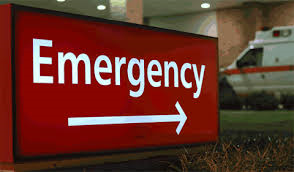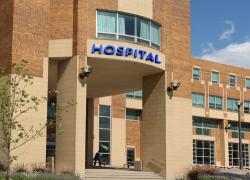 For many healthcare organizations, the emergency room is the hub of high-speed drama and intrigue, and with these qualifiers comes the reality of financial impact. An emergency department’s ability to consistently bring in revenue will either make or break it – so, how can hospitals assure that their throughput is sufficient?
For many healthcare organizations, the emergency room is the hub of high-speed drama and intrigue, and with these qualifiers comes the reality of financial impact. An emergency department’s ability to consistently bring in revenue will either make or break it – so, how can hospitals assure that their throughput is sufficient?
 For many healthcare organizations, the emergency room is the hub of high-speed drama and intrigue, and with these qualifiers comes the reality of financial impact. An emergency department’s ability to consistently bring in revenue will either make or break it – so, how can hospitals assure that their throughput is sufficient?
For many healthcare organizations, the emergency room is the hub of high-speed drama and intrigue, and with these qualifiers comes the reality of financial impact. An emergency department’s ability to consistently bring in revenue will either make or break it – so, how can hospitals assure that their throughput is sufficient?
1. Understand the queue – Improved ED Throughput
Queuing up- or, “standing in line” as we tend to casually say- is something that we all do from time to time in various social situations where we need to patiently wait for our turn – at the grocery store, the bank or perhaps most notoriously, the Department of Motor Vehicles. Queuing up for medical services- particularly emergency medical services – however, is undesirable.
If you have patients waiting for services then you already have an issue within your ED workflow: you don’t have enough supply for the demand, where supply is your staff and demand, of course, are your patients. While a doctor’s office with a certain number of patients may be able to accurately schedule just enough patients for the staff available on a given day, an emergency room is at the beck and call of the patients. One day, an emergency room census might get so low that nurses are sent home – other days, nurses who are not scheduled or physicians who have requested time-off may need to be pulled in to meet the need for treating more patients than would be considered average.
While it’s impossible to know, precisely, how many patients your ED will see in a day, by looking at your census on a longitudinal axis, you can perhaps see events and seasons that seem to correspond with an uptick in utilization. Perhaps you find that during the week of an annual festival in your community, your census jumps up beginning the first weekend and continuing into the subsequent week, since there are more people in town than usual. When it comes to scheduling, you can prepare yourself next year by requiring additional staff to work during that time.
You can also be looking ahead for potential outbreaks which may be soon to affect your demographic area – perhaps, then, you would have more doctors or nurses on call in anticipation of more cases.
For many reasons, both practical and psychological, people don’t enjoy waiting. Furthermore, many patients don’t understand the concept of triage – they think, naturally, that if they arrived before someone else they should be treated first. They grow resentful and frustrated when someone comes in and gets medical attention straight away when they have been waiting for, perhaps, an hour.
To help clarify, it might be helpful to post informational graphics that are easy to comprehend and read in your waiting room, and to have staff be prepared to give a simple but enforceable explanation of the triage process.
2. Value transparency – Improved ED Throughput
To piggy-back on the previous tip, it should be said that no matter how prepared you are most days, there will inevitably be events that you could not have adequately prepared for. Accidents or public health crisis require a different kind of preparedness – the ability to communicate that your department is in the midst of chaos, but that you have procedures in place to make sure things are still running smoothly.
In times like these, what you can’t offer patients is usually a timeline – because this has become a variable that you no longer have any control over. What you can do, however, is improve their confidence by exhibiting humble transparency about the situation and assuring them that everyone is doing their job and working to the top of their licensure in an attempt to keep things orderly and efficient.
That being said, in times of distress patients deserve your honesty. You’d always be surprised at how far simple social graces can get you in trying times. Consistent updates, rounding and even just acknowledging the patient’s patience (a simple “thank you” will do) means a lot more to an anxious waiting room than feeling forgotten about.
3. Consider letting someone else do the paperwork – Improved ED Throughput
Many doctor’s offices nationwide have made use of scribes to eliminate the need for primary care physicians to sit behind a computer and document during an office visit. In the high-turnover environment of an emergency room, document-as-you-go technology isn’t practical for physicians and nurses. That is, unless there was a specific role in the ED who could provide this service.
No doubt taking the real-time documenting responsibility from the medical staff would speed things up and allow doctors more time to diagnose and treat patients. Hiring medical scribes, who are often graduate medical students, to work alongside medical staff and “do the paperwork” can be an asset to a bustling department. Furthermore, these young grad students are often at the crux of technological advancement and many of them can double in “super user” roles for electronic medical record systems, which all contributes to medical staff doing more hands on patient care, and less hands on computer keyboards.
4. Get LEAN – Improved ED Throughput
Lean management has taken healthcare by storm in the last several years. Many hospitals are using the management style throughout the organizations – including the emergency department.
The general idea behind Lean management is increasing efficiency, improving value and reducing waste. These general principles work for any business, but are particularly of interest to healthcare organizations. Some Lean tactics that have been increasingly implemented in emergency departments are open-bed assignment, rapid-triage and using Ishikawa diagrams to identify areas of waste.
In a previous series on Lean management, guest blogger Patrick Christopher discussed the increasing momentum of Lean management in healthcare organizations nationwide. He defines the Lean process as follows:
- Identification of customer value
- Management of “value stream”
- Developing capabilities of flow production
- Use of “pull” mechanisms to support flow of materials at constrained operations
- Pursuit of perfection through reducing to zero all forms of “waste”
In healthcare, you can consider patients your customers and think about value in terms of the care that patients receive at your facility. Focusing on increasing patient satisfaction and the value of the care you provide will take you a long way in terms of creating a more sustainable -and competitive- healthcare organization.






